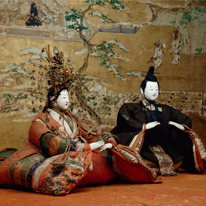Past Exhibitions
- Feature Exhibition: Hina Matsuri and Japanese Dolls
- February 27, 2016 - March 21, 2016
The Japanese Doll Festival, or Hina Matsuri, is a holiday that takes place each year on the March 3rd. In honor of this celebration, the Kyoto National Museum presents its annual exhibition of outstanding Japanese dolls.
The Doll Festival originated out of a purification rite known as Jōshi no Sekku (the first Day of the Snake), which took place somewhere around the third day of the third lunar month each year. Dolls originally functioned as katashiro—inanimate substitute representations used to draw away impurities and malevolent spirits from actual people. These representations could then be floated away or otherwise destroyed, taking human pollutants with them.
It was in the beginning of the Edo period (1615–1868) that such ritual objects were transformed into luxurious figurines used to decorate interior spaces. At the time, girls from samurai or courtier families used to gather on the third day of the third month for hiina asobi (lit., doll play) theme parties, at which they would play house and make gifts of dolls. The emperor and empress (dairi bina) and other hina dolls displayed on tiered altars during the Doll Festival today combine the talismanic qualities of katashiro with the elaborateness of dolls once gifted by members of the elite. Even within the limited category of hina dolls, there are many variations. Some Edo period examples are named after the eras with which they are associated, as in the Kan’ei dolls (kan’ei bina, named after the Kan’ei era, 1624–1645) or Kyōho dolls (kyōho bina, after the Kyōhō era, 1716–1736). The jirōzaemon bina dolls are named after a Kyoto doll maker, Jirōzaemon, who is credited with their design. The Kokin dolls (kokin bina; lit., “old and new dolls”) were first made in Edo instead of Kyoto, while the courtier dolls (yūsoku bina) faithfully represent the costume and hair conventions of the Kyoto aristocracy. The extensive range of hina dolls in this exhibition offers you the opportunity to look carefully at differences in their details, including facial expressions, gestures, and costumes.
In modern day Japan, it has become increasingly rare to see any large hina altar displays in private residences, much less the palace-style examples featured here, which were popular in the Kansai region. Hina are not the only kind of dolls made in Japan’s rich doll culture. Palace (gosho) dolls and Kamo dolls were used as gifts by the Kyoto imperial family and aristocracy. Costume dolls (ishō ningyō) reveal customs of the day, while mechanical dolls (karakuri ningyō) perform sophisticated tasks.
We hope that this exhibition gives a glimpse into the doll-related traditions that were so deeply embedded in Edo-period culture.












